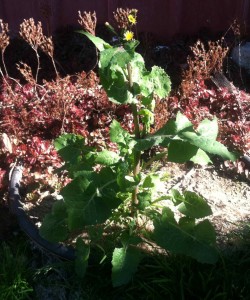
The weed looked just like something the chickens would like to eat. Then, when I pulled it, it actually felt like the leaves would be tender and juicy. I put it in the bucket with the scratch grains and some frost damaged tomatoes that I was picking for my flock. I was pretty sure that the chickens wouldn’t eat it if it wasn’t good for them. When I dumped it all on the dirt in the pen, several chickens went straight for the weed. This was particularly noteworthy because this group of hens had always headed for the grain first, no matter what else was offered at the same time. I had been giving tomatoes, cabbage, cantaloupe, and even lettuce. They always eventually ate it all, but the grain was first choice. Until THIS weed. I wondered how they knew! I knew I had to figure out what weed it was.
It turns out to be a smooth sow thistle, only having the descriptor of “thistle” because of some soft, non-sharp spines on the perimeter of the leaves. I had thin gloves on when I handled it and I did not feel any prickles like I do with real thistles. There is nothing thorny or pin-like anywhere else on the plant. The word “sow” is because the weed was known as good food for mama pigs. The pre-fix of “smooth” is due to there being another sow thistle that has more jagged leaf edges. If it is growing in the shade, it may have a deeper green color. If it gets a lot of light, it can lead to a reddish hue or areas on the leaves.
My little Weeds Golden Guide says there are 45 species of sow thistle worldwide, but only 3 of them are common in the United States. The smooth sow thistle is one of those. It is also called things like hares lettuce and milk thistle (not to be confused with milk weed). The flowers look very much like dandelion flowers, but the unique spiraling arrangement of the leaves up the stem helps with identification. The base of the leaves grow directly from the stem in a semi-wrapped fashion, without any section of branch (petiole)to let it wave more freely. The shape of the leaves varies as they proceed up the stem. Near the base they tend to have a distinct lobe on the outer end. When the weed is young, the lobe is more oval. As it grows, the lobes takes on more of a heart shape. The lower leaves can get quite large. I have seen some in my yard the size of a foot print. Further up the stem, the leaves can become just elongated ovals, smaller and skinnier. However, many of the ones in my yard seem to have the wide leaves all the way to the top.

The single stem of the smooth sow thistle is hollow and soft, only branching near the top when it is time to flower. By that time, it can be anywhere from one to six feet tall. I have definitely had some in my yard reach four feet in height. If either the stem or the leaves are broken, a milky white sap leaks out. Some sources say this is bitter. Some sources say the weed is good for salad or for cooking as a spinach substitute. Most animals will also eat it.

The tap root of the smooth sow thistle is unimpressive, but since the soft stem breaks so easily, it works best to thoroughly loosen the soil around it before pulling. Even after that, pulling near the base of the plant is the most sure way of getting it up by the root.
I have noticed this weed growing about 9 months of the year in my yard, not as prolifically as some, but ever present. It is still both germinating and blooming in mid October. Whether it is an annual or a perennial can depend somewhat on the climate, but there is one of the species that is specifically known as perennial sow thistle. Its root are much more of a problem and it tends to grow from any broken pieces left in the ground. That is not usually a problem with smooth sow thistle. However, dying in the winter probably won’t hold back the smooth sow thistle with its 140 seeds per flower, resulting in 5000-40,000 seeds per plant. All it takes is a little bare soil with a few nutrients. The seed is mostly spread by birds eating the seed, the seed floating on water, and thin hairs attached to the seed acting as parachutes. For now, I think I will try to keep up with removal as best I can. Other lettuce and spinach sounds more appealing. The birds can have what goes to seed, mostly because I can’t stop them.

